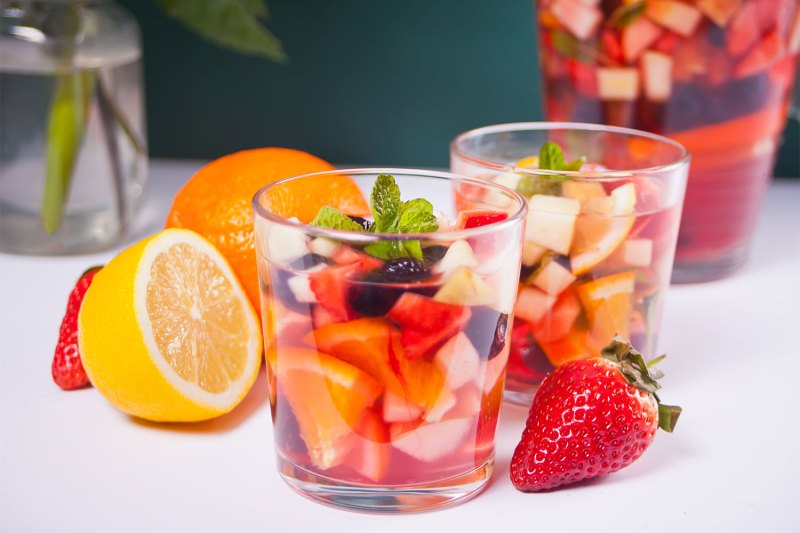When most people think of Spanish wine cocktails, their minds immediately land upon sangria, the wine, brandy and fruit combo that’s now completely ubiquitous at stateside bars, especially in the summertime. However, when I spent a summer in the seaside town of Marbella on Spain’s Andalusian coast, I became very well acquainted with a fizzy wine-based libation that’s so widely beloved that you can buy it in 2L bottles at coastal Spanish Aldi stores: tinto de verano.
What is tinto de verano?
“Tinto de verano” translates to “red wine of summer,” and this fitting name comes from its area of origin: The southern coast of Spain. In Spanish beach cities like Málaga and Marbella, you’ll find tinto de verano (often shortened to “tinto”) at cafes, beach bars, supermarkets … just about everywhere. “[Tinto de verano] is a light, refreshing take on enjoying wine. Similar to the beer versions, called shandies, radlers, or panachés, tinto de verano lightens the intensity of the wine and adds a citrusy flavor to it, as well as light carbonation,” explains master sommelier and VP of beverages Emily Wines of Cooper’s Hawk Winery & Restaurants.
Tinto de verano’s popularity likely has something to do with its simplicity; this drink really couldn’t be easier to make. Unlike its close relative sangria, tinto doesn’t require brandy or any other liqueurs. It’s just equal parts red wine and citrus soda, with seasonal fruit thrown in as a garnish. In Spain, it’s frequently made with a low-sugar sparkling lemonade, but according to chef/owner Hilda Ysusi of Broken Barrel in Woodlands, Texas (whose family hails from coastal Spain), there’s no shame in using the lemon-lime or grapefruit soda of your choice. “Making this cocktail is easy; [just use] equal parts red wine and Sprite. I sometimes like to use Squirt (grapefruit soda) as it is less sweet and gives the drink an unexpected twist,” Ysusi tells us.
What kind of wine works best in tinto de verano?
Because tinto de verano includes a citrus-soda mixer, Wines cautions against using a “high-end [red] wine.” Her preferences lean toward “lighter, fresher styles of red wine. Spanish Garnacha, French Côtes-du-Rhône, Pinot Noir are all great options.”
But some tinto fans, like Ysusi, prefer to use a red that can hold its own even in the context of a punch-style cocktail like this one. “I like to use strong tannic grapes like Cabernet Sauvignon or Tempranillo; that yields a very good balance of flavors when adding the soda,” she says.

Using a top-dollar bottle of red for tinto probably isn’t the most budget-friendly move (or the best way to enjoy the nuances of the wine), but wine and beverage director Maurice DiMarino of the Cohn Restaurant Group in California does urge tinto makers to select a red wine a level or two above what they’d use for sangria. “I would use higher-quality reds for tinto de verano instead of what we use in sangria. The cheap wine used in sangria is often concealed by the alcohol from the flavorful brandy and fruit. In a tinto de verano, the wine quality is paramount. I recommend using a red wine in the 13.5% ABV [range] and above. I prefer to use one made with thick-skinned varietals and one that has tannins. This will give the drink more mouthfeel. If I’m making it at home, I look for wines from Spain such as Monastrell from Jumia or Bobal from Yecla. Tenpranillo is also good, but I prefer it to come from a warmer climate than Rioja, such as La Mancha. These wines are big, powerful, fruity reds … excellent for this drink!” DiMarino tells The Manual.
Are there variations on tinto de verano that are worth a try?
Tinto de verano’s formula isn’t a complicated one (only two ingredients!), so there’s abundant room for variation. We asked our professional tinto fans for their favorite spins on classic tinto, and here’s what they recommend:
Upcycled tinto de verano
If you’d rather swap in higher-end ingredients for the typical low-cost wine and Sprite, then DiMarino has a tinto recipe for you: “My favorite way to make tinto de verano is to use 0.5 oz of Domaine Sante Riesling Grape Nectar as your source of sugar, 3 oz of one of a flavorsome Spanish red, 3 oz of Fever Tree Citrus Tonic. [I’ll then] squeeze [in some] lemon & lime and fill the glass with ice. I prefer using a natural sugar source rather than Sprite or 7-Up because these sodas are made with high fructose corn syrup. The grape nectar makes perfect sense, because it perfectly fuses with wine. I chose Riesling because it has more floral and citrus flavors to contrast with the red wine and meld with the tonic.”
Sangria
As we mentioned previously, tinto de verano and sangria have a lot in common. In fact, Ysusi calls tinto de verano as “the not-so-well-known cousin of sangria, and equally — if not more — delicious.” Tinto’s higher soda content gives it more effervescence than a typical sangria, which is why Ysusi says that she always pictures herself “drinking tinto de verano by a body of water or on a terrace or a huge patio. I like to drink it before the meal or in the middle of the afternoon; some tapas are a great accompaniment “ To turn tinto into sangria, you’ll need to add brandy and steeped fruit (since tinto’s fruit garnishes are usually fresh and don’t spend time absorbing alcohol before they’re served).
Kalimotxo
Tinto isn’t the only Spanish wine beverage that prominently features flavored soda. “Another variation popular in Spain is a Calimocho or Kalimotxo, which combines cola with wine,” says Emily Wines. Kalimotxo enjoys particular popularity in the Basque region of Spain, and it’s best served over ice with a wedge of orange on the side. Because of the cola’s sweetness, a dry and tannic red wine works especially well in this cocktail.



